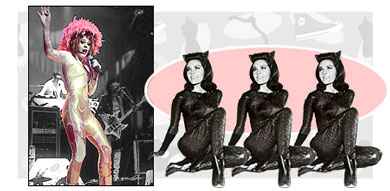Body suits / Leotards / Catsuits

Fashion Synopsis
Meow.
Body suit, leotard, or catsuit? They could be long-sleeved or sleeveless, scoop necked or turtleneck style, ankle length or just covering the butt, but whatever the variation, these form-fitting stretch body suits were the ultimate in slinky style and casual comfort.
The first ‘leotard’ was a bulky body sweater created by trapeze artist Jules Leotard in 1859. The one-piece body suit, made from primitive stretch wool, reached to wrists and ankles, allowing Leotard to swing through the air in aerodynamic grace without sagging shirts or falling hems. After a few improvements in the comfort arena, the functional leotard was adopted by circus performers and dancers. It remained under the big top and in the studio until the suit stepped out onto the street in the 50’s as a part of beatnik fashion.
At a time when good girls wore sweater sets, the beat ladies paired black body suits with skirts or capri pants for a rebellious statement. The second skin nature of the slinky suit made the bodysuit a little daring, and when worn outside the dance studio, a lot shocking. By the time the 60’s swung around, more outrageous styles would steal the spotlight, and the body suit would become the foundation of the Glam and Mod uniform. As Mary Quant introduced micro-miniskirts and Courreges blasted off into the space age, bodysuits offered coverage and comfort under these outrageous fashions.
A neck-to-ankle, all-over body suit made its fashion debut during the 60’s. The space-age 60’s predicted the body-conscious suit as a base for which all other fashions would be layered upon. Think of the slim-fit suits of Star Trek, Buck Rogers, Logan’s Run or any of the futuristic shows that presented us with their vision of the future. Superheroes like Superman and Batman already knew the relative ease the full body suit offered, and embraced it as their uniform.
When worn by women, the full body suit was dubbed the catsuit, as worn by Catwoman of Batmanfame. Her black patent leather suit made her powerful, confident, with a slinky grace fit for a superheroine. Emma Peel from The Avengers epitomized the swinging 60’s vixen in her cut-out black leather catsuit. Even Josie and the Pussycats donned leopard print bodysuits in tribute to their favorite feline.
When a world of women was going braless, the bodysuit helped to keep things from getting out of hand. The 70’s moved the leotard to the disco floor, and shiny spandex was placed with super-tight satin pants and slinky belts. These leotards could groove with you all night and not move an inch.
After a past performance as a counterculture fashion, leotards joined the ranks of classic casual wear. The 80’s aerobics phenomenon tossed dance leotards to the streets once again, but this time in pastel Xanadu colors. The allure of shiny spandex submitted to the powers of matte with the advent of cotton lycra, and comfort was even greater with the move to softer fabrics. The early 90’s paired cotton lycra bodysuits with baggy jeans as hip-hop hit the streets, and Dee-Lite’s Lady Miss Kier brought back the catsuit in psychedelic patterns, as paired with platforms.
They’ve changed form over the years, but body suits have remained a staple of the fashion world. And besides, you’ve got to love an outfit that’s embraced by Star Trekkers, superheroes, acrobats and aerobicisers alike.
